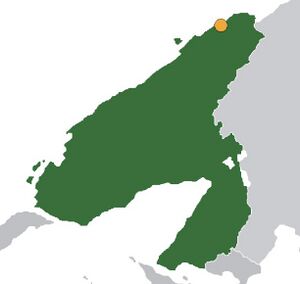1993 Saterocian nuclear test
This article is incomplete because it is pending further input from participants, or it is a work-in-progress by one author. Please comment on this article's talk page to share your input, comments and questions. Note: To contribute to this article, you may need to seek help from the author(s) of this page. |
| 1993 Saterocian nuclear test | |
|---|---|
 Map showing estimated location of the test | |
| Information | |
| Country | Sateroc |
| Test site | Crafere Nuclear Test Site, Cascutia |
| Date | May 20, 1993 |
| Period | 02:32:16 SLT |
| Number of tests | 1 |
| Test type | Unknown |
| Device type | Fission |
| Max. yield | Estimated at least 18 kiltotons(75 TJ) |
| Test series chronology | |
The 1993 Saterocian nuclear test was the detonation of a nuclear device conducted by Sateroc on May 20, 1993.
Days before, on 12 May, Andre Puoc and the Saterocian government announced its intention to conduct a nuclear test. The blast is estimated to have had an explosive force of around 18 kilotons, however the actual number is unknown due to Sateroc's secretive nature. Radioactive output was detected following the blast in the Northern Ocean following the estimated time of the blast, as well as seismic activity in the general area.
Reportedly, a few embassies in Kolkesburg were given a 15-minute notice of the oncoming nuclear test, and these unnamed countries warned other governments, such as bigger nations and intergovernmental organizations, of the supposed nuclear test. Minutes before the test, it was announced that a Saterocian nuclear test was 'imminent', prompting other nations to prepare condemnations.
Background
By the 1970s, Sateroc was under the leadership of dictator Andre Puoc, who had become paranoid following the assassination of his father and former Saterocian dictator, Tilmann Puoc. Puoc blamed the assassination on Vœyetskan and Saroqi operatives operating in Kolkesburg against the dictatorship, however it was later found out that the perpetrator was a Cascutian nationalist as part of the War in Cascutia. However, these strong accusations caused tensions to mount between Sateroc and its neighbors, kickstarting the Vasilin Sea crisis.
Vasilin Sea crisis
The Vasilin Sea crisis was a period of heightened tensions between Sateroc and multiple countries in the Vasilin Sea, starting after Sateroc's first invasion of Sateroc and ending after the 2019 Saterocian Revolution. The crisis was also heavily tied with the War in Cascutia, a low-intensity asymmetrical conflict in the region of Cascutia between Cascutian militias and the Saterocian government. Starting in the late 80s, both of these conflicts began to rapidly escalate after aggressive moves by Puoc, who was seeking to "dominate" Sateroc's neighbors politically, militarily, and economically after he began "reclamation efforts" in the Vasilin Sea. This led to the Saterocian Navy making moves in the Vasilin Sea, going out into international waters, and sometimes even nearing national waters of other countries which were at odds with Sateroc.
During the 1990s, both sides of the crisis were preparing for a potential military conflict, as it was a time when both the Saterocian and Vœyetskan navies were sinking ships and even some naval vessels, which prompted international condemnation against Sateroc. Puoc, which had grown extremely paranoid by this point, feared of a potential western invasion of Sateroc, which of course never came, however forced the regime to rethink its strategy.
Saterocian nuclear program
By the mid-1980s, it was clear that Sateroc was maintaining a clandestine nuclear weapons program, due to the completed construction of various nuclear reactors across concealed and undisclosed locations in Cascutia. However, almost no diplomatic means were used by the international community to limit Sateroc's nuclear weapons program due to Puoc's general stubborness. Instead, international sanctions were placed on Sateroc, hoping to economically and diplomatically pressure Sateroc into cutting the program. Sateroc, which had become heavily self-reliant, continued work on the program, constructing more nuclear reactor locations and further developing scientific research. By 1990, rumors circulated that Sateroc was pursuing nuclear enrichment technology, and that same year Sateroc claimed that they had a "right" to possess nuclear weapons.
By this point, diplomatic agreements were proposed by other nations, however Sateroc refused to cooperate, drawing even more international condemnation. In 1992, a year before the nuclear test, Sateroc allowed scientists from around the world to inspect its plutonium production facilities in southern Cascutia, and some of these scientists claimed that Sateroc had already been able to produce a nuclear weapon, however others stated that although their research seemed to be going successfully, they had not been able to produce nuclear weapons of any kind yet. In 1995, a foreign senior scientist claimed that Sateroc's nuclear weapons program was much more advanced than originally anticipated in 1992 during the scientists' visit.
In late 1992, Sateroc claimed to have made "massive breakthroughs" in its nuclear weapons program, claiming that they had processed plutonium into a workable nuclear deterrent. frantic diplomatic attempts by international governments were made to reach an agreement concerning the Saterocian nuclear weapons program, however little achievements were made in making any sort of progress. Throughout the rest of 1992 and into 1993, the nature Sateroc's nuclear weapons program remained ambiguous due to the absence of any actual nuclear test. While while most, if not all scientist organizations had agreed that the Saterocian regime was capable of producing a nuclear weapon of mass destruction, there was little agreement in how powerful the weapon could be, with some claiming a potential yield of less than one kilotons, up to 25 kilotons in yield.
Threats made by Puoc
On May 9, Saterocian government officials claimed